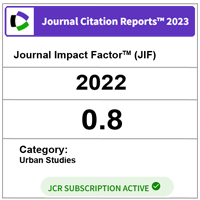Representation of National Identity in Malaysian State Mosque Built Form as a Socio- cultural Product
DOI:
https://doi.org/10.11113/ijbes.v5.n1.243Keywords:
National identity, state mosque, Malaysian architecture, political symbol, socio-cultural product.Abstract
The formation of national identity is the essence for a multi-racial country like Malaysia because it can strengthen national solidarity, create a common aspiration, and sustain the continuity of a historical heritage with multiple ethnicity and background. Nevertheless, the characteristics of this national identity is still not fully dealt with from an architectural aspect. Hence, the purpose of this paper is to critically examine the problem of national architectural identity in Malaysia. This is vital to uncover the resulting design principles with national architectural identity characteristics by referencing to three typologies of local state mosque as case study. The finding outlines that there are six architectural principles that influence the formation of national identity. These are the understanding of built form detail elements, materials usage, local style composition and expression, application of organic theory, designing a regionalistic articulation of space and form as well as an understanding of democratic values form to reflect the characteristics of national identity. These established referential guideline design on national identity is of benefit for future designers, builders, developer and related authority to produce built form that symbolizes nation political values as well as responsive to the existing social culture context.References
Abel, C., (2000). Architecture and Identity: responses to cultural and technological change. Routledge.
Abel, C. and Foster, N., (2012). Architecture and identity. Routledge.
Aga Khan Award for Architecture (Organization), Universiti Teknologi Malaysia, Malaysia. Kementerian Kebudayaan and Belia dan Sukan, 1983. Architecture and Identity: Proceedings of the Regional Seminar in the Series Exploring Architecture in Islamic Cultures (Vol. 1). Aga Khan Award for Architecture.
Avcioglu, N., (2007). Identity-as-form: the mosque in the West. Cultural Analysis, 6, pp.91-112.
Barthes, R., (1994). The semiotic challenge. Univ of California Press.
Chandler, D., (2017). Semiotics: the basics. Routledge.
Chun, H.K., Hassan, A.S. and Noordin, N.M., (2005). An influence of colonial architecture to building styles and motifs in colonial cities in Malaysia. In 8th International Conference of the Asian Planning Schools Association.
Czumalo, V., (2012). Architecture and identity.
DASIK., (2017) Dasar senibina identiti kebangsaan http://www.lam.gov.my/downloads/Forms/Uncategorized/derafdasik_15sep2017.pdf (accessed in August 2017)
De Saussure, F., (1985). The linguistic sign.
Dovey, K., (2009). Becoming places: urbanism/architecture/identity/power. Routledge.
Ee, K.J., (1983). An approach to the search for identity. Architecture and Identity.
Eldemery, I.M., (2009). Globalization challenges in architecture. Journal of Architectural and Planning Research, pp.343-354.
Fiske, J., (2010). Introduction to communication studies. Routledge.
Gottdiener, M., (1995). Postmodern Semiotics Material Culture and the Forms of Postmodern Life.
Gottdiener, M., (2003). Recapturing the center: A semiotic analysis of shopping malls. na.
Hawkes, T., (2003). Structuralism and semiotics. Routledge.
Hodge, R., Hodge, R.I.V. and Kress, G.R., (1988). Social semiotics. Cornell University Press.
Leeds-Hurwitz, W., (2012). Semiotics and communication: Signs, codes, cultures. Routledge.
Ismail, A.S. and Alice, D., (2008). Discourse of Democratic Architecture in Malaysia: An Analysis of Putrajaya Government Building in Comparison to Parliament Building. Engaging Malaysia Modernity 50 Years and Beyond.
Ismail, A.S. and Rasdi, M.T.M., (2010). Mosque architecture and political agenda in twentieth-century Malaysia. The Journal of Architecture, 15(2), pp.137-152.
Ismail, A.S., (2008). The influence of Islamic political ideology on the design of state mosques in West Malaysia (1957-2003) (Doctoral dissertation, Queensland University of Technology).
King, A., (2004). Spaces of global cultures: architecture, urbanism, identity. Routledge.
Lefaivre, L. and Tzonis, A., (2003). Critical regionalism: architecture and identity in a globalized world. Prestel Publishing.
McGregor, W.B., (1997). Semiotic grammar.
Morgado, P., (2008). The Construction of Cultural Identity in Contemporary Architecture. Architecture and Identity, 9, p.165.
Özkan, S., (1996). Faith and the Built Environment: Architecture and Behaviour in Islamic Cultures. Architecture & comportement
Shamsul, A.B., (1996). Debating about Identity in Malaysia: A Discourse Analysis (< Special Issue> Mediating Identities in a Changing Malaysia).
Shamsul, A.B., (2001). A history of an identity, an identity of a history: the idea and practice of „Malayness‟ in Malaysia reconsidered. Journal of Southeast Asian Studies, 32(3), pp.355-366.
Smith, A.D., (1991). National identity. University of Nevada Press.
Smith, D.J., (2000). Architectural Experience: A composition of viewpoints (Doctoral dissertation, Queensland University of Technology).
Vale, L., (2014). Architecture, power and national identity. Routledge.
Van Leeuwen, T., (2005). Introducing social semiotics. Psychology Press.
Downloads
Published
How to Cite
Issue
Section
License
Copyright of articles that appear in International Journal of Built Environment and Sustainability belongs exclusively to Penerbit Universiti Teknologi Malaysia (Penerbit UTM Press). This copyright covers the rights to reproduce the article, including reprints, electronic reproductions or any other reproductions of similar nature.
Authors who publish with this journal agree to the following terms:
- This Journal applies Creative Commons Licenses of CC-BY-NC-SA
- Authors retain copyright and grant the journal right of publication with the work simultaneously licensed under a Creative Commons Attribution License that allows others to share the work with an acknowledgement of the work's authorship and publication in this journal.
- Authors are able to enter into separate, additional contractual arrangements for the non-exclusive distribution of the journal's published version of the work (e.g., post it to an institutional repository or publish it in a book), with an acknowledgement of its publication in this journal.
- Authors are permitted and encouraged to post their work online (e.g., in institutional repositories or on their website) prior to and during the submission process, as it can lead to productive exchanges, as well as earlier and greater citation of published work (See The Effect of Open Access).







